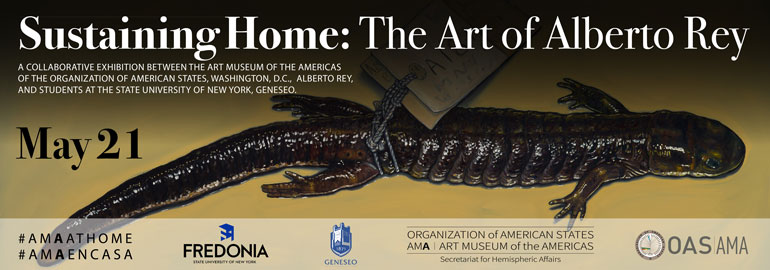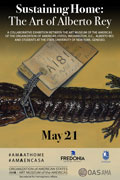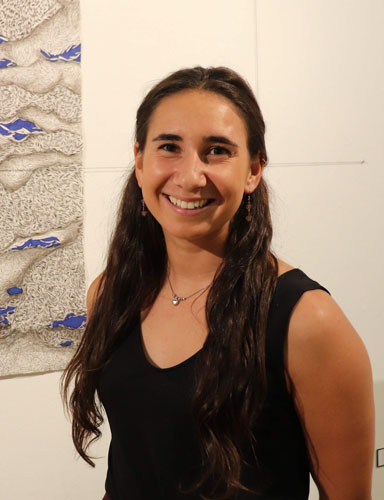
Rachel Mihlstin is a Senior Art History Major and Museum Studies Minor at SUNY Geneseo. She says that was grateful to work on this exhibition because it gave her the opportunity to analyze and work with such an intuitive artist. Doing so allowed her to look at all of the different identity influences that can go into an artist’s work. She was awarded The Pam Eder Prize for Excellence, Annual Art History Department Symposium, SUNY Geneseo (2021).
On social media May 30, 2021
Biological Regionalism and the Aesthetics of Death
by Rachel Mihlstin
The two series, Biological Regionalism and The Aesthetics of Death, by Alberto Rey, share a common subject matter that addresses life, death and decay as part of a natural cycle of existence. The Aesthetics of Death has a similar formalist composition to the Biological Regionalism series but focuses more the end of a life cycle Rey studied and related to the cycle of our own lives. Biological Regionalism also reflects Rey’s scientific research, using a realistic style similar to scientific illustrations used in textbooks. Similarities and differences alike, both series reflect Rey’s identity as they explore major events that shaped his life.
The two series also reveal an overarching theme that addresses Rey’s interest in environmentalism and on his continuing reflection on his identity as a Cuban American. The arch that connects the two series is the existence of the natural lifecycle manifested specifically in the life, death and decay of trout, in The Aesthetics of Death VII, Brown Trout, Willowemoc River, Catskills, New York and Willowemoc River, Catskills, New York VI. The fish in both series are depicted in similar style with intentional variations, as one series represents the history of Rey’s treasured environment and the other expresses his personal history.
While Rey’s biological and environmental interests are visually present in his work, as part of his study of the natural world, the fish he depicted in The Aesthetics of Death series relate symbolically to Rey’s identity as a Cuban American. The intersection of contemporary ideas like science, death and identity in art and his perspective on the traditional genre of fishermen is Rey’s contribution to the landscape and naturalistic American Art movement that was started with Winslow Homer and Thomas Cole. Rey represents a new generation of American artists who are self-reflective in their art. American landscape artists, such as Homer and Cole, were consistently trying to share their story and it was a story that was intertwined with significant social and environmental issues of their time. Rey’s Aesthetics of Death continues these American traditions of engagement with the natural and social world in a way that reflects his personal experience and his Cuban American identity. In The Aesthetics of Death series, Alberto Rey explored a stage of his life that was marked by personal loss through family deaths. In an interview, with the class in which I am a participant this Spring Semester, he said he began realizing the fragility of life, during this time in his life, but also he internalized how in the natural world there is a cycle of life ending in death, which is antithetical to how people usually separate and isolate death from life. Rey used The Aesthetics of Death series to meditate on how death is just one step of the overall and natural cycle of life.
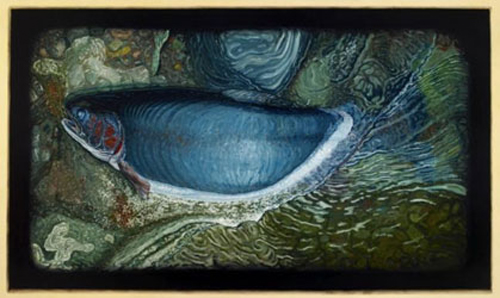
The Aesthetics of Death: Aesthetics of Death: VII, 2006-2008, Oil on Plaster, 72 x 120”
When looking at Alberto Rey’s Aesthetics of Death VII, the spectator comes across a vibrant, recently deceased fish and not a rotting, decayed carcass, as is found in other paintings in this series. This painting is very large and gives its audience a bird’s-eye-view of the fish washed into the shallows. The scale of the painting allows for a realistic but also painterly style. When looking up close at the surface of this work, you can see the brushstrokes and the painting may even look abstract from very close up but stepping back allows you to see there is extreme detail, in the scales of the fish and the ripples of the water. There is not a grim tone to this image of death, as the topic of death is countered by the fish’s vibrant colors including its scarlet red vital fluids. The recentness of the death along with the vibrant colors plays into Rey’s idea that death is a step in the larger cycle of life and breaks down how the majority of people view life as being vibrant and sparkling, while death is dark and still.
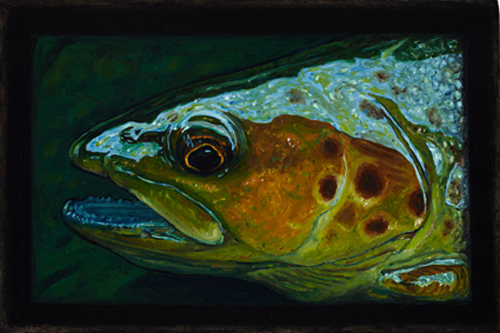
Biological Regionalism: Brown Trout, Willowemoc River, Catskills, New York, 2014, Oils on Plaster, 6 x 8"
While the Aesthetics of Death and the Biological Regionalism series share similar subject matter, Biological Regionalism has a more objective viewpoint on fish in their environment, using what Alberto Rey called an “anthropological composition” with the subject directly in the middle of the frame. There is a definite connection in the nature and style of this painting to the manner and style of scientific illustrations, a topic Rey has also tackled in his Lost Beauty series, which has stark similarities to anthropological and scientific illustrations. Similar to Aesthetics of Death, the imagery and symbolism connected to fish is present but Biological Regionalism’s purpose is to show Rey’s passion for the environment. Rey’s biological and environmental research may have inspired these realistic paintings as they are similar to scientific illustrations. Brown Trout, Willowemoc River, Catskills, New York I and VI also include extreme detail and composition reflecting a bird’s eye view. Once again, the depicted trout displays vibrant colors and is also surrounded by an energetic environment. The green of the fish contrasts beautifully with the red rocks it lays on while the reflection of the blue sky reveals the water surrounding the fish. There is a connection to the similarities of this painting and scientific illustrations.
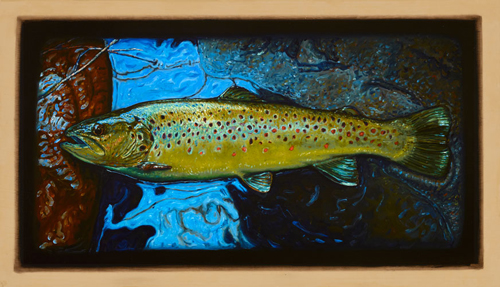
Biological Regionalism: Brown Trout, Willowemoc River, Catskills, New York VI, 2012, Oils on Plaster, 19 x 33"
Another compositional device Rey utilized in the Biological Regionalism series is the fish swimming in its environment, not laid out in the shallows. This viewpoint can be seen in Brown Trout, Willowemoc River, Catskills, New York VI where the viewer gains a closer look at the face of the trout. This painting displays the details of the fish differently from that other two but still has a realistic yet painterly style. With Modernism in art, a realistic style is for documentation and illustration purposes, but Rey’s style has artistic brushwork and introduces an impressionistic manner of painting modernity. The fish, in the painting, is depicted alive and within its environment and is seen watching us, as compared to the other two paintings, where the spectator had found the fish. This painting breaks from the aspects of the scientific illustration idea and brings the spectator/participant into the environment.
Connecting Biological Regionalism and The Aesthetics of Death allows Alberto Rey’s audiences to see and to connect with a major theme in Rey’s work, which meticulously joins the interlacing of his identity to his interests in creating a collective body of work addressing important and contemporary issues – such as environmentalism and his dual identity as an immigrant Cuban American. Rey is constantly commenting about the beauty of the environment and his own personal experiences as he travels and moves in his perpetual search for a home and a grounded identity. The two topics are not mutually exclusive, looking at the lifecycle arches in the two series shows that Rey’s environmental concerns are aligned with his own history.

